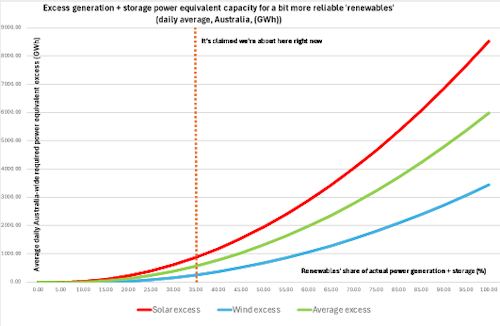Annually, Australia-wide, solar power averages 'fully on' about 15% every day, and 85% 'fully off'. So average 'reliable' solar requires 24 hours of power to be generated in 3.6 hours. 20.4 hours must be stored for dispatch later. Actual solar generation capacity must be 6.7 times base-load + 'peaker' generation capacity. In addition, battery storage for solar must be 5.7 times greater. Total solar equipment capacity must be 12.4 times base-load + 'peakers'. Plus transmission.
Annually, Australia-wide, wind power averages 'fully on' about 30% every day, and 70% 'fully off'. So average 'reliable' wind requires 24 hours of power to be generated in 7.2 hours. 16.8 hours must be stored for dispatch later. Actual wind generation capacity must be 3.3 times base-load + 'peaker' generation capacity. In addition, battery storage for wind must be 2.3 times greater. Total wind equipment capacity must be 5.6 times base-load + 'peakers'. Plus transmission.
'Reliable' required hydro power capacity is harder to generalise. It depends, inter alia, on very few specific hydro sites, and reliable water availability (even for very inefficient 'pumped hydro').
Advertisement
Things get more demanding as Australia as a whole moves towards full reliance on 'unreliables'. There's less scope for 'extension cords' between states (inter-connectors) to spread the power demand load. And less access to base-load + 'peaker' fossil fuel power for back-up. Anywhere.
Australia-wide, (not just for the NEM), based on the latest full-year estimates:
- Power generation in 2023 was about 273,106GWh.
- That's an average of about 748.2GWh per day. Every single day of the year.
- Baseload + 'peaker' actual generation capacity could match that, at 748.2GWh per day.
- For 100% solar, generation + battery capacity needed is 9,277.7GWh equivalent per day.
- For 100% wind, generation + battery capacity needed is 4,189.9GWh equivalent per day.
- With a 50:50 mix of solar and wind, capacity needed is 6,733.8GWh equivalent per day.
As Australia increases its reliance on 'unreliables', their capacity equivalent power requirements increase a lot, even for just a bit more reliability. As do their costs. See chart below.

It's worse.
Advertisement
These intermittency numbers are year-averages, applying every day of the year. Multi-day periods without sun, wind droughts, water droughts, are normal. More 'unreliables' generation + storage power equivalent requirements needed, if governments want them to be more 'reliable'.
These cost lots even as generation costs fall (when weather permits any generation at all).
It's even worse. To meet partly reliable targets, seasonality alone greatly multiplies 'unreliables' capacity + cost problems (my OLO pieces of 11.06.24 and 9.07.24, on NEM costs only, refer).
These lessons are best learned before the event. And avoided.
Australia looks like learning them after.
Discuss in our Forums
See what other readers are saying about this article!
Click here to read & post comments.
4 posts so far.